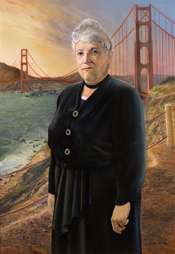Florence Prag Kahn
Florence Prag Kahn (November 9, 1866 – November 16, 1948) was an American teacher and politician who in 1925 became the first Jewish woman to serve in the United States Congress. She was only the fifth woman to serve in Congress, and the second from California, after fellow San Franciscan Mae Nolan. Like Nolan, she took the seat in the House of Representatives left vacant by the death of her husband, Julius Kahn.
Florence Prag Kahn | |
|---|---|
 | |
| Member of the U.S. House of Representatives from California's 4th district | |
| In office March 4, 1925 – January 3, 1937 | |
| Preceded by | Julius Kahn |
| Succeeded by | Franck R. Havenner |
| Personal details | |
| Born | Florence Prag November 9, 1866 Salt Lake City, Utah |
| Died | November 16, 1948 (aged 82) San Francisco, California |
| Political party | Republican Party |
| Spouse(s) | Julius Kahn |
| Alma mater | University of California, Berkeley |
Life and career
Kahn was born in Salt Lake City, Utah to Conrad and Mary Prag, Jewish Polish immigrants who befriended the Mormon leader Brigham Young, and sold supplies during the gold rush. Her family moved to San Francisco, California in 1869. She graduated from the San Francisco Girls' High School in 1883, and received an A.B. from the University of California, Berkeley in 1887. She taught high school English and History. She married Julius Kahn in 1899, who served in Congress until his death on December 18, 1924.

Florence Kahn was elected as a Republican to the 69th Congress, by special election, to fill the vacancy caused by the death of her husband, who had just been re-elected to a 13th term. She was reelected to the 70th, 71st, 72nd, 73rd, and 74th Congresses, serving from December 7, 1925 to January 3, 1937. She was the first woman on the House Military Affairs Committee.
Kahn supported Herbert Hoover's unsuccessful campaign against Franklin Delano Roosevelt in the 1932 presidential election. She was an unsuccessful candidate for reelection to the 75th Congress in 1936.
Afterwards, Kahn actively tried to get women involved in politics. She was a member of the American Association of University Women, Hadassah and the Council of Jewish Women. She was a Reform Jew, and belonged to Congregation Emanu-El of San Francisco.
Kahn died in San Francisco, and was interred in the Home of Peace Cemetery in Colma, California.
Location of source materials relating to Florence Prag Kahn
The Western Jewish History Center,[1] of the Judah L. Magnes Museum,[2] in Berkeley, California has a large collection of family papers, documents, correspondence, and photographs relating to Florence Prag Kahn and to her husband, Julius Kahn.
See also
References
- "Western Jewish History Center -- The Magnes". 14 June 2006. Archived from the original on 14 June 2006.
- "Comeon voucher code January 2019". ComeOn voucher code.
- United States Congress. "Florence Prag Kahn (id: K000002)". Biographical Directory of the United States Congress.
- Seymour Brody. (1996) "Florence Prag Kahn". Jewish heroes & heroines of America: 150 true stories of American Jewish heroism. ISBN 0-8119-0823-2.
- Florence Kahn: Congressional Widow to Trailblazing Lawmaker Multimedia presentation created by the Office of History and Preservation, Office of the Clerk of the U.S. House of Representatives.
External link
![]()
| U.S. House of Representatives | ||
|---|---|---|
| Preceded by Julius Kahn |
Member of the U.S. House of Representatives from California's 4th congressional district 1925–1937 |
Succeeded by Franck R. Havenner |